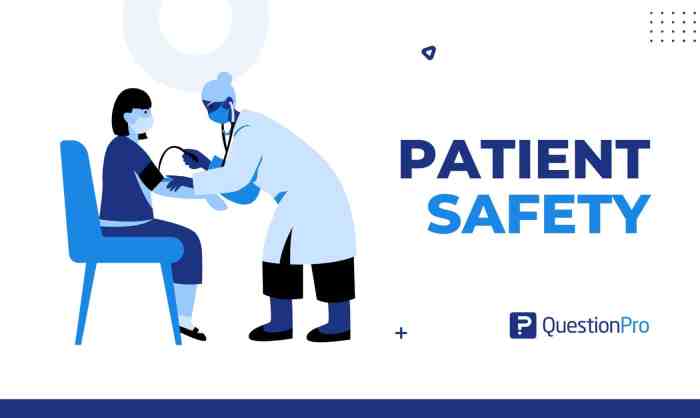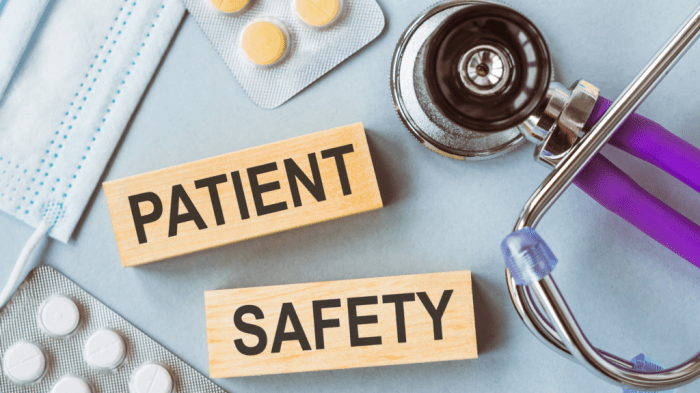
With Patient Safety Guidelines at the forefront, this paragraph opens a window to an amazing start and intrigue, inviting readers to embark on a storytelling filled with unexpected twists and insights. Patient safety is paramount in healthcare, and these guidelines play a crucial role in safeguarding patients. Let’s delve into the key components and practices that enhance safety standards.
Patient safety guidelines are not just rules; they are a lifeline in healthcare settings, ensuring quality care and minimizing risks. By understanding how these guidelines are developed and implemented, we can create a safer environment for all.
Patient Safety Guidelines
Patient safety guidelines play a crucial role in healthcare settings to ensure the well-being and protection of patients. These guidelines are established to minimize the risk of harm and errors during medical procedures and treatments.
Key Components of Effective Patient Safety Guidelines
- Clear communication protocols among healthcare staff to prevent misunderstandings.
- Standardized procedures and protocols for different medical situations.
- Regular staff training and education on patient safety practices.
- Systems for reporting and analyzing medical errors to prevent future occurrences.
- Implementation of technology to streamline processes and reduce human errors.
Role of Patient Safety Guidelines in Reducing Medical Errors
- By following established guidelines, healthcare providers can identify potential risks and take preventive measures.
- Standardized protocols help in ensuring consistency and accuracy in medical procedures.
- Patient safety guidelines promote a culture of accountability and continuous improvement in healthcare facilities.
Development and Updating of Patient Safety Guidelines
Patient safety guidelines are developed through collaboration among healthcare professionals, regulatory bodies, and experts in the field. These guidelines are regularly updated based on new research, best practices, and feedback from healthcare providers. Continuous improvement and adaptation to changes in the healthcare landscape are essential for the effectiveness of patient safety guidelines.
Patient Safety Practices
Ensuring patient safety in healthcare facilities is a top priority to prevent harm and promote well-being. Implementing best practices and protocols is essential to maintaining a safe environment for patients.
Common Practices to Enhance Patient Safety
- Strict hand hygiene protocols to prevent the spread of infections.
- Proper patient identification procedures to avoid medication errors and misdiagnosis.
- Effective communication among healthcare team members to ensure accurate information exchange.
- Regular equipment maintenance and checks to guarantee functionality and safety.
Protocols for Compliance with Patient Safety Guidelines
- Adherence to medication administration protocols to prevent errors in dosage or medication mix-up.
- Utilization of checklists for surgical procedures to reduce the risk of surgical errors.
- Implementation of fall prevention strategies for at-risk patients to minimize the occurrence of falls.
Significance of Staff Training in Patient Safety Practices
Proper training of healthcare staff is crucial in upholding patient safety practices. It ensures that all team members are knowledgeable about protocols, procedures, and best practices to mitigate risks and respond effectively to emergencies.
Role of Technology in Supporting Patient Safety Efforts
- Electronic health records (EHR) systems help streamline information sharing and reduce errors related to paper-based records.
- Barcode scanning technology enhances medication administration accuracy by verifying patient identity and medication details.
- Automated alerts and reminders in digital systems help prevent missed treatments or follow-ups, improving patient outcomes.
Reporting and Monitoring

Reporting incidents related to patient safety is a crucial aspect of healthcare systems. It involves documenting any adverse events, near misses, or errors that occur during patient care. This information helps identify areas for improvement and prevention of future occurrences. Monitoring and analyzing data derived from these reports play a key role in enhancing patient safety measures.
Importance of Monitoring and Analyzing Data
- Regular monitoring of patient safety data allows healthcare facilities to identify trends and patterns that may indicate areas of concern.
- Analysis of this data helps in understanding the root causes of incidents and implementing targeted interventions to prevent similar occurrences in the future.
- Tracking and monitoring data over time provide valuable insights into the effectiveness of patient safety initiatives and the impact of any implemented changes.
Feedback Mechanisms for Enhancing Patient Safety
- Establishing feedback mechanisms allows healthcare providers to receive input from staff, patients, and families regarding safety concerns or suggestions for improvement.
- Feedback helps in fostering a culture of transparency and continuous learning within healthcare organizations, leading to better patient outcomes.
- Acting on feedback received can result in the implementation of new policies, procedures, or training programs aimed at enhancing patient safety practices.
Role of Quality Assurance Teams
- Quality assurance teams play a critical role in monitoring patient safety compliance by conducting regular audits, reviews, and assessments of clinical practices.
- These teams ensure that healthcare facilities adhere to established safety protocols, guidelines, and regulations to minimize risks and prevent errors.
- Collaborating with other departments, quality assurance teams work towards improving patient safety outcomes and maintaining a high standard of care delivery.
Patient Engagement

Patient engagement plays a crucial role in promoting safety in healthcare settings. By involving patients in their own care, healthcare providers can improve outcomes and reduce the risk of errors. This active participation empowers patients to take control of their health and safety, leading to better overall experiences.
Ways to Involve Patients in Promoting Safety
- Encouraging patients to ask questions about their treatment plans and medications
- Providing educational materials and resources for patients to understand their conditions
- Involving patients in shared decision-making processes regarding their care
Impact of Patient Engagement on Healthcare Outcomes
- Increased adherence to treatment plans and medications
- Reduced medical errors and adverse events
- Improved patient satisfaction and overall quality of care
Initiatives Empowering Patients to Participate in Their Care
- Patient portals for accessing medical records and communicating with healthcare providers
- Patient advisory councils to provide feedback and input on hospital policies
- Education programs on patient safety and empowerment
Role of Communication in Fostering Patient Engagement for Safety
- Clear and open communication between patients and healthcare providers builds trust and enhances safety
- Encouraging patients to report concerns or ask questions can help identify potential safety issues early
- Effective communication ensures that patients are fully informed and actively involved in their care decisions
In conclusion, Patient Safety Guidelines are the cornerstone of safe healthcare practices, guiding professionals to prioritize patient well-being above all. By incorporating these guidelines into daily routines and fostering patient engagement, we can collectively enhance the quality of care and outcomes. Safety first, always.
Key Questions Answered
How are patient safety guidelines developed?
Patient safety guidelines are typically developed by experts in the field who review current practices, research, and feedback to establish best practices that prioritize patient well-being.
Why is patient engagement important for safety?
Engaging patients in their care increases awareness, promotes adherence to treatment plans, and empowers them to communicate effectively with healthcare providers, ultimately improving safety outcomes.
What role do quality assurance teams play in patient safety?
Quality assurance teams are responsible for monitoring compliance with safety guidelines, identifying areas for improvement, and implementing strategies to enhance patient safety within healthcare facilities.





